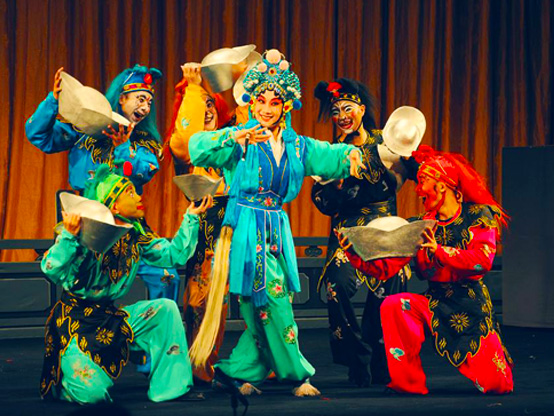
39 items of human intangible cultural heritages in China have been listed in into the UNESCO Human Intangible Cultural Heritage Representative List. It is the most numerous in the world. Among these, eight items of human intangible cultural heritages are related to Jiangsu Province.
Dragon Boat Festival
端午节


Dragon Boat Festival is originated from China. In the very beginning, it is a festival for people to drive away the disease. In Wu and Yue area, people used to hold the dragon-boat race on the fifth day on the lunar May. Later, it became a memorial day for the great poet Qu Yuan. People are used to eat Rice Dumpling, drink realgar wine, hold the dragon-boat race, and hang the calamus, wormwood and folium artemisiae argyi.
Experience Place:
Stone City Park ,Nanjing (May 28th, 2017)
Kun Opera
昆曲


Kun Opera is one of the oldest opera genres in China, which originated in the Suzhou Taicang in the 14th century. Later, it was reformed by Wei Liangfu and then spread to the whole nation. Since the middle of Ming Dynasty, it has been famous in China’s opera genres for nearly 300 years.
Kun Opera is a composite of singing, speaking, acting, playing, dancing and acrobatic, which is famous for the elegant lines, euphemistical tune, and exquisite acting. It is praised as “the mother of hundred operas”. The Kun Opera was listed as the “representative work of human oral and intangible cultural heritage” by the UNESCO.
Experience Places:
Jiangsu Kun Opera Theatre (Nanjing)
Jiangsu Suzhou Kun Opera Theatre (Suzhou)
Chinese Zither
古琴


Chinese Zither is a traditional plucked string instrument of the Han People. It has been existed for over 3000 years, and ranked first in the four of the traditional cultural art. In November 2003, Chinese Zither has been listed in the human intangible cultural heritage by the UNESCO.
Most of the various genres of Chinese Zitherwere originated from Jiangsu. For example: Guangling School in Yangzhou, Yushan School in Changshu, Jingling School in Nanjing, Mei’an School in Nantong, Wumen School in Suzhou, Mengxi Zither Hall in Zhenjiang, and Tongshan Zither Hall in Xuzhou. Changshu is praised as "the hometown of the Chinese Zither", and the first Chinese Zither Art Festival was held here.
Experience Places:
Jinling Chinese Zither Gallery (Nanjing)
Changshu Chinese Zither Art Gallery (Suzhou)
Chinese Zither Art Garllery (Yangzhou)
Mei’an School Chinese Zither Art Gallery (Zhenjiang)
Paper Cutting
剪纸


Paper cutting is a kind of most popular art and folk art. It can be cut on the paper, gold and silver foil, bark, leaf, cloth, leather, and so on. In 2009, the paper cutting has been listed in the “UNESCO Intangible Cultural Heritage”.
Jiangsu paper cutting is distributed in Xuzhou, Yangzhou, Nanjing, Cahngzhou Jintan and Nantong. The most influenced one is Yangzhou Paper Cutting and Nanjing Paper Cutting. Besides, the Xuzhou Pi County paper cutting is also a representative of the Graceful School.
Experience Places:
Yangzhou Paper Cutting Museum (Yangzhou)
Nanjing Folk Museum, Confucius Temple (Nanjing)
Jintan Paper Cutting Institution (Changzhou)
Woodblock Printing
雕版印刷


This is the earliest printing method in China. The earliest existing woodblock printing is the Diamond Sutra (collected by the Great Britain Museum) in 868 BC. In spite of this, the woodblock printing technique was appeared about 2000 years ago.
The Woodblock Printing enjoys the fame of “living fossil” in printing history. Yangzhou is the birthplace of China’s Woodblock Printing, as well as the only city that preserves the complete ancient woodblock printing techniques. The Chinese government puts much emphasize on protecting such techniques. In 2009, the Woodblock Printing was selected into the "UNESCO Intangible Cultural Heritage" as the core techniques in woodblock printing.
Experience Places:
Jinling Scripture Engraving Place (Nanjing)
Guangling Ancient Books Printing House (Yangzhou)
Timber- framed Structure
传统木结构营造


The traditional timber-framed structure is the oldest traditional craftsmanship of the Han People. The traditional architectures of the Han People are mainly timber-framed made by soil, wood, brick, tile and stone. The division of the labor includes: carpentry work, joinery work, tile-roofing, brickwork, stonework, oilwork, decorative painting, and so on. Among these, the carpentry work occupies the leading function.
Such kind of skills is passed on from generation to generation by words and deeds. The representative one is the Xiangshan School in Suzhou, which has been a famous architecture genre in ancient architecture history. It also has fame of “all of the carpentry are made from Xaingshan”.
Experience places:
Yi Garden, Yanjia Garden (Suzhou)
Sericulture Silk Weaving
蚕桑丝织


Sericulture silk weaving is a cultural mark of the Han People. For 5000 years, it has made great contributions to Chinese history and human civilization. In order to protect such kind of cultural heritage, Zhejiang, Jiangsu and Sichuan jointly applied to the UNESCO human oral and intangible cultural heritage list in the name of the Chinese Silk Museum. And in 2009, it was formally enrolled.
Jiangsu people started the silk production 5000 years ago. The machine silk industry in modern times emerged after 1840. The representative skills in Jiangsu is the Ke silk weaving skill and brocade weaving skill in Suzhou.
Experience Place:
Suzhou Silk Museum (Suzhou)
Nanjing Brocade
云锦


Nanjing Brocade (Yunjin) is a traditional Chinese silk handicraft and has existed for 1580 years. It was named due to the brilliant color like the cloud in the sky. Yunjin is different from Shujin and Songjin in the decoration with gold, rich and free color, and the striking figures. It can be divided into three categories: Kuduan, Kujin, and Zhuanghua.
Currently, only Nanjing produces the Yunjin and keeps the traditional features and unique skills in the original way. It has been enrolled in the Human Intangible Cultural Heritage List in 2009.
Experience Places:
Jiangning Imperil Silk Manufacturing Museum (Nanjing)
Nanjing Yunjin Museum (Nanjing)